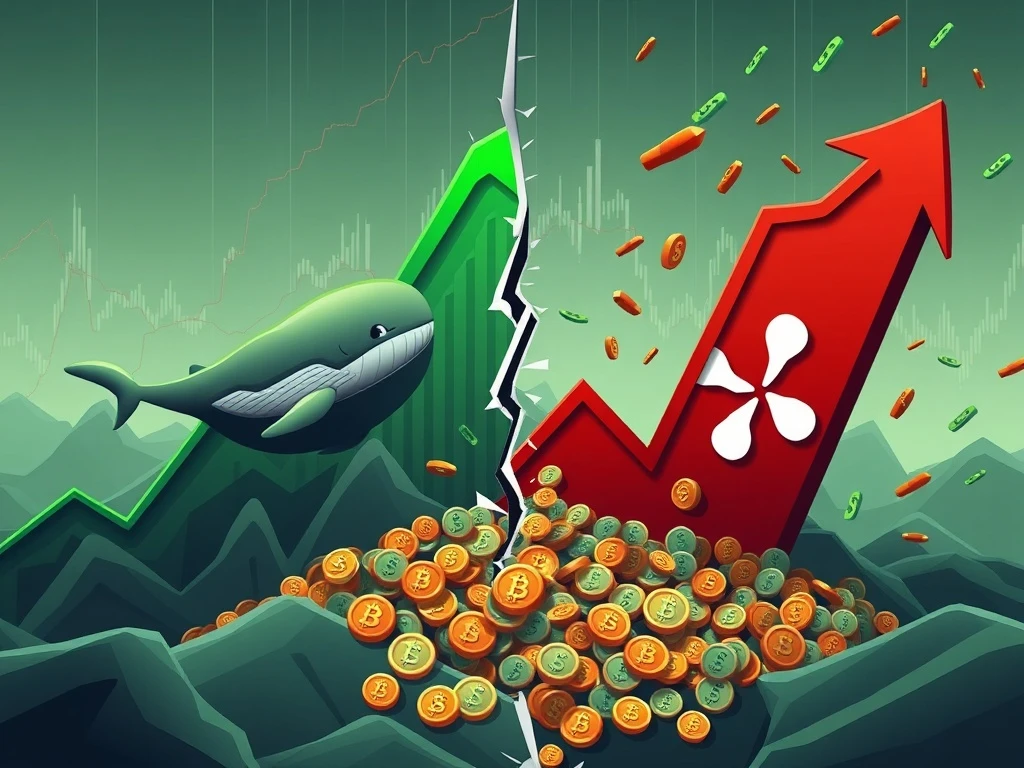XRP News Today: Bitcoin Cash Skyrockets 8% as XRP Plummets 14% Amid $105M Liquidations

The cryptocurrency market is a whirlwind of unpredictable movements, where fortunes can shift in moments. Recently, we witnessed a dramatic divergence: Bitcoin Cash (BCH) celebrated a significant ascent, while XRP, a long-standing altcoin, faced a sharp decline. This period of heightened activity offers crucial insights into the forces shaping digital asset valuations, from powerful whale movements to cascading liquidations. Understanding these dynamics is key for anyone navigating the complex world of crypto. Let’s dive into the latest XRP news and the broader market implications.
Bitcoin Cash Surge: Unpacking the Whale Activity
Bitcoin Cash (BCH) recently captured market attention with an impressive 8% climb. This surge wasn’t just a random fluctuation; it was directly linked to a staggering 97.77% spike in whale activity. For those new to the term, ‘whales’ are large cryptocurrency holders whose transactions can significantly influence market prices due to their sheer volume. In BCH’s case, large transactions totaling 1.69 million units were observed, signaling concentrated buying interest from these influential players.
This substantial accumulation pushed BCH towards a critical resistance level of $565. Historically, this price point has acted as a formidable barrier, often preceding significant price corrections—some over 50%. While the current Bitcoin Cash surge indicates strong bullish momentum, the historical precedent at $565 introduces a note of caution. Investors are now closely watching whether BCH can decisively break this level or if history will repeat itself, leading to a potential pullback.
XRP News: What Caused the 14% Plunge?
In stark contrast to BCH’s ascent, XRP experienced a tumultuous week, plummeting more than 14%. This sharp decline was primarily triggered by two significant events: a massive $105 million in liquidations and a substantial $175 million transfer of XRP from Ripple co-founders’ wallets to various exchanges. Such large transfers typically increase the available supply on exchanges, often leading to short-term selling pressure as more tokens become accessible for trading.
The liquidations played a major role in amplifying XRP’s downturn. When traders use leverage to open positions, and the market moves against them, their positions can be automatically closed or ‘liquidated’ to prevent further losses. The $105 million figure indicates a significant number of leveraged long positions on XRP were wiped out, creating a cascading effect that pushed prices even lower. This highlights the inherent risks of leveraged trading, especially in volatile markets.
Contrasting Metrics: Adoption vs. Technicals
Despite the short-term bearish price action, on-chain data offered a glimmer of long-term hope for XRP. Reports indicated that approximately 7,500 new addresses were joining the XRP network daily. This consistent growth in network participants is a strong signal of gradual adoption and expanding utility, suggesting underlying foundational strength for the asset. However, this positive adoption metric currently contrasts with bearish technical indicators, where the token struggled to maintain key support levels. Analysts suggest that XRP’s long-term potential, including a potential rise to $15, hinges on its ability to sustain critical support above $2.99.
Crypto Liquidations: A Broader Market Impact
The turbulent week wasn’t confined to XRP alone. The broader cryptocurrency market witnessed over $1 billion in crypto derivatives liquidations. This massive liquidation event affected various altcoins, with XRP and Dogecoin (DOGE) being prominent examples of assets experiencing significant declines. The scale of these liquidations underscores the market’s sensitivity to sudden price movements and the amplified risks associated with highly leveraged positions across the ecosystem.
Ethereum (ETH) and XRP together accounted for a substantial portion of this market turmoil, leading a combined $976 million liquidation wave. Such events expose the fragility within altcoin markets, where liquidity can be thin and price swings exacerbated by leveraged trading. Even Bitcoin, the market leader, felt the pressure, with its four-hourly price dipping 1.8% to $116,365, despite derivatives trading volume surging to $131.6 billion in 24 hours, reflecting intense trading activity.
Understanding Whale Activity and Market Dynamics
The recent market movements offer a clear lesson in the power of whale activity. Bitcoin Cash’s rally was directly attributable to large-scale accumulation by these significant holders, often attracting institutional attention and signaling confidence in the asset’s short-term prospects. Conversely, XRP’s liquidity crunch, partly driven by large transfers, showcased the vulnerability of assets to substantial sell-offs initiated by influential entities.
This duality—institutional accumulation driving up prices on one hand, and large transfers creating selling pressure on the other—is a constant feature of the crypto market. It highlights the importance of monitoring on-chain data for large transactions, as these can often precede significant price shifts. Retail investors need to be aware that sudden liquidity shifts can drastically alter market outcomes, emphasizing the need for robust risk management strategies.
Navigating Altcoin Volatility: Strategies for Investors
The past week underscored the inherent altcoin volatility. While some smaller-cap assets like Solana (SOL) and Dogecoin (DOGE) managed to post double-digit gains, defying the broader downturn in some segments, many altcoins faced considerable pressure. Bitcoin dominance, which fell below 62%, indicates that capital flowed into some smaller assets, but this doesn’t guarantee safety for all. The market remains cautious, with investors scrutinizing every move.
For investors, these events are a reminder of the crypto market’s dynamic nature. Diversification, understanding the difference between fundamental adoption (like XRP’s new addresses) and short-term technical indicators, and prudent use of leverage are crucial. Staying informed about whale movements and overall market sentiment can provide an edge in navigating these turbulent waters. The ability to distinguish between short-term noise and long-term potential is paramount for sustained success.
The recent contrasting performances of Bitcoin Cash and XRP offer a microcosm of the broader cryptocurrency market. It’s a landscape defined by rapid shifts, driven by both fundamental developments and the significant influence of large market participants. While BCH demonstrated the power of concentrated buying, XRP’s struggles highlighted the risks of leveraged positions and large supply injections. As the market continues to evolve, understanding these complex interactions will remain vital for investors seeking to make informed decisions.
Frequently Asked Questions (FAQs)
What caused Bitcoin Cash (BCH) to surge recently?
Bitcoin Cash surged 8% primarily due to a significant spike in whale activity, indicating large investors were accumulating the asset. This involved large transactions totaling 1.69 million BCH units, pushing its price higher.
Why did XRP plummet by 14%?
XRP’s 14% drop was largely due to $105 million in liquidations of leveraged positions and a $175 million transfer of XRP from Ripple co-founders’ wallets to exchanges, which increased selling pressure on the market.
What are crypto liquidations and why are they significant?
Crypto liquidations occur when a trader’s leveraged position is automatically closed by an exchange due to insufficient margin to cover losses. They are significant because large-scale liquidations, like the recent $1 billion event, can trigger cascading sell-offs and exacerbate market downturns, impacting multiple assets.
Does XRP’s increasing number of new addresses contradict its price decline?
Not necessarily. While 7,500 new addresses joining the XRP network daily indicates strong long-term adoption and network growth, this fundamental strength can be overshadowed by short-term market dynamics such as whale transfers, leveraged trading, and broader market sentiment, leading to temporary price declines.
What is the significance of the $565 resistance level for Bitcoin Cash?
The $565 level is a critical resistance point for Bitcoin Cash because it has historically been associated with significant price corrections, including declines of over 50% in previous instances. Breaking above this level could signal continued bullish momentum, while failure could lead to a substantial pullback.
How does whale activity influence cryptocurrency prices?
Whale activity, involving large transactions by major holders, can significantly influence cryptocurrency prices. Large purchases (accumulation) can drive prices up, while large sales (distribution) can lead to price drops, creating volatility and impacting market sentiment for both institutional and retail investors.










